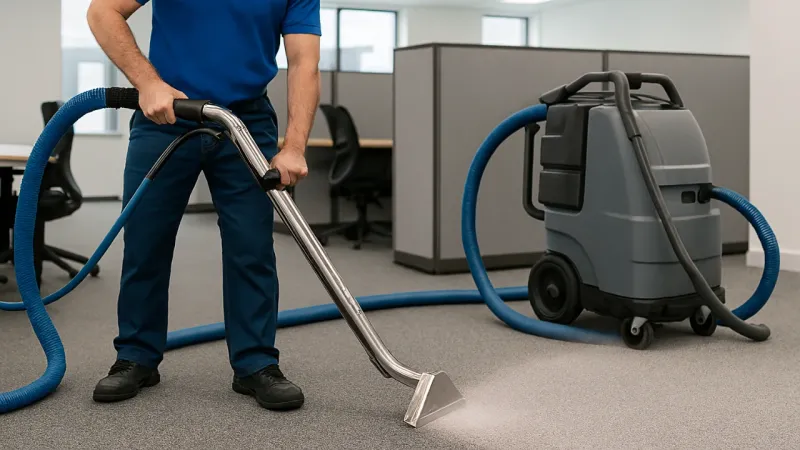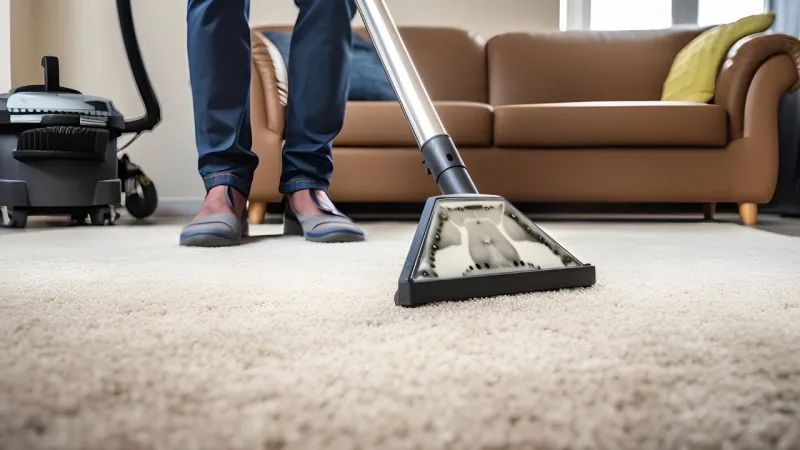Carpets add warmth, style, and comfort to any space, but keeping them clean is essential for both appearance and hygiene. Whether it’s the heavy foot traffic of an office or the cozy comfort of your home, carpets face different kinds of wear and tear. This is where professional carpet cleaning comes in, but not all cleaning is the same.
Today, we will show you the key differences between commercial and professional carpet cleaning, so that you can determine which one you need for your space.
What Is Commercial Carpet Cleaning?

Commercial carpet cleaning is a professional service designed to maintain the cleanliness and appearance of carpets in businesses and workplaces. It often requires specialized equipment and techniques to handle the unique demands of high-traffic areas and potentially larger spaces. Unlike basic vacuuming, commercial carpet cleaning involves techniques like steam cleaning or encapsulation, which deep clean and remove embedded dirt, stains, and allergens.
What Is Residential Carpet Cleaning?

Residential carpet cleaning is the process of cleaning carpets within a home to remove dirt, stains, and allergens, improving the overall appearance and hygiene of the living space. Carpets at home accumulate dirt, dust, and allergens over time, impacting indoor air quality and the overall cleanliness of the home. Residential carpet cleaning ensures the hygiene of these carpets through dry cleaning, shampooing, etc.
Key Differences Between Commercial and Residential Carpet Cleaning
There are a lot of significant differences between commercial and residential carpet cleaning in scope, methods, and equipment used. Key differences include scale and area size, equipment, material, frequency, stain and dirt, and drying time.
The key differences between commercial and residential carpet cleaning are described below:
1. Scale and Area Size
Commercial and residential carpet cleaning differ significantly when it comes to scale and area size. Here’s how:
- Commercial: Commercial spaces can range from hundreds to thousands of square feet, including multiple rooms, hallways, and even entire floors. These areas experience significantly more foot traffic, leading to faster and more substantial dirt buildup.
- Residential: Residential spaces typically involve smaller areas like bedrooms, living rooms, and hallways, usually measured in hundreds of square feet. The cleaning methods also vary depending on the materials used in the carpet.
2. Equipment and Power
There are big differences between commercial and residential carpet cleaning in the equipment used and the power they provide. The differences are:
- Commercial: Commercial cleaning involves using heavy-duty, industrial-grade machines. These machines include highly powerful motors and larger tank capacities for cleaning large areas quickly and effectively.
- Residential: Residential cleaning usually involves smaller, lighter, and more portable machines designed for furniture and in smaller spaces. These have lower motor power and water pressure, which may not be sufficient for deep cleaning in high-traffic areas or for removing heavily embedded dirt.
3. Carpet Material Types
Commercial and residential carpets are different in their construction and materials, primarily due to the different demands placed on them. Here’s how they are different:
- Commercial: Commercial carpets are made of low-pile and durable materials like nylon, olefin, or polypropylene for stain and moisture resistance. These carpets are designed to withstand heavy foot traffic, potential spills, and frequent cleaning, so they require less maintenance and are treated with stain-resistant chemicals.
- Residential: Residential carpets are made of materials like wool, polyester, and blended fibers, as homeowners often prioritize softness and insulation featuring a higher pile height for a softer feel underfoot. They may require more regular cleaning and maintenance due to spills and pet stains.
4. Frequency of Cleaning
The key difference in cleaning frequency between commercial and residential carpet cleaning lies in the volume of foot traffic and the nature of the space. Here’s why they differ:
- Commercial: Businesses like offices, retail stores, and restaurants experience significantly more foot traffic than homes, leading to faster carpet wear and dirt accumulation. Due to this higher traffic and potential for spills and stains, they often require more frequent cleaning.
- Residential: Homes generally have less foot traffic than commercial spaces, resulting in slower dirt accumulation. This is why they require less frequent cleaning, but it can be adjusted based on individual needs and preferences, like the presence of pets or children.
5. Stain and Dirt Challenges
Levels of stain and dirt challenges vary among commercial and residential carpets due to varying traffic levels and engagement. Here’s how they are different:
- Commercial: High foot traffic leads to more dirt, dust, and grease buildup in commercial spaces, requiring more frequent and thorough cleaning. Stubborn stains from spills, tracked-in mud, and general wear and tear are common in commercial carpets.
- Residential: Residential areas, especially single-family homes, generally experience lower traffic, resulting in less dirt accumulation. So there is comparatively less amount of stains and dirt, possibly just pet stains, food spills, and dust.
6. Drying Time
The differences in drying time between commercial and residential carpet cleaning depend on the cleaning method used and the specific needs of the environment. Here’s how:
- Commercial: Commercial spaces prioritize faster drying to minimize business disruption, often using low-moisture methods. As commercial clients prioritize quick drying to get back to business as usual, they use dry cleaning or encapsulation methods to minimize downtime.
- Residential: Residential clients may be more willing to tolerate longer drying times with traditional steam cleaning for a deeper clean. Factors like carpet material, humidity levels, and ventilation can significantly impact drying time. It also provides the advantage of flexible cleaning times as there are no specific busy or working hours.
Commercial vs Residential Carpet Cleaning – Comparison Table
A table comparing the differences between commercial and residential carpet cleaning is given below:
| Factors | Commercial Carpet Cleaning | Residential Carpet Cleaning |
| Scale and Area Size |
|
|
| Equipment and Power |
|
|
| Carpet Material Types |
|
|
| Frequency of Cleaning |
|
|
| Stain and Dirt Challenges |
|
|
| Drying Time |
|
|
Which One Do You Need?
The type of carpet cleaning service you need depends on what you need it for, and it could be either your office or your house. However, you can get professional carpet cleaning services for both your workplace and your household from us.
Commercial carpet cleaning is needed when you are running high-traffic areas like offices, schools, medical facilities, hotels, restaurants, and retail stores. These areas experience high foot traffic and can accumulate dirt, stains, and odors, necessitating professional cleaning. Additionally, some businesses like theaters, churches, and senior living facilities also benefit from regular commercial carpet cleaning.
On the other hand, if you want to maintain a healthy and clean home environment, choose residential carpet cleaning. Regular cleaning removes dirt, dust, allergens, and bacteria that accumulate in carpets, improving indoor air quality and potentially preventing allergy and asthma symptoms. Additionally, it extends the life of your carpets by preventing wear and tear from trapped debris and can enhance the overall appearance of your home.
FAQs
How often should commercial carpets be cleaned?
Commercial carpets should be cleaned at least every 3-6 months.
Can residential cleaners handle small office spaces?
Residential cleaners may not have the experience, equipment, or specialized training to handle the demands of a commercial space.
Is hot water extraction better for commercial carpets?
Yes, hot water extraction is generally considered the most effective method for deep cleaning commercial carpets.
Do both services use eco-friendly solutions?
Many commercial and residential carpet cleaning services are increasingly offering eco-friendly options.
Can residential carpet cleaning be done DIY?
Yes, residential carpet cleaning can be done DIY.
Conclusion
Understanding the difference between commercial and residential carpet cleaning ensures you get the right care for your floors. Commercial cleaning deals with high-traffic areas with durable, large-scale methods, while residential cleaning focuses on gentle, detail-oriented approaches suited for home environments. By choosing the right service, you not only protect your carpet’s appearance but also extend its lifespan and maintain a healthier space.
Need more professional advice on how you can keep your space clean? Stay connected with us and never miss an update!

